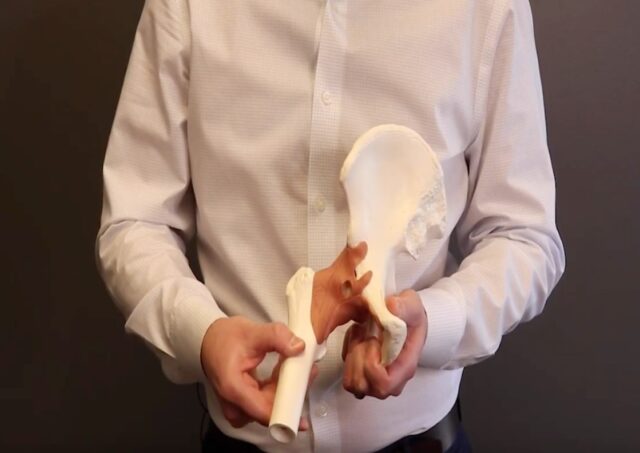Many folks are surprised to learn that hip surgeries have been conducted for over 300 years, or at least that’s as far back as history has recorded. The sophisticated operation of today certainly has come a long way from the tedious and often dangerous surgeries of the past.
In 2010, the Centers for Disease statistics show that more than two million hip arthroplasties were performed. So, what was a once innovative and dangerous operation has now become fundamental.
The History of Hip Replacements

Amputation became the course of treatment for major injuries and skeletal tissue damage, but this wasn’t the best option when it came to hip issues.
Though there were upper femur replacements on record in the 1700s, it wasn’t until 1821 that the actual first hip replacement was on paper. The history of hip replacements is quite eye opening to see how far the medical community has come.
•1800s
In London, Anthony White of the Westminster Hospital was the first person to conduct such a surgery. He worked in medical centers in the larger cities of France, Germany, and even Philadelphia.
By 1891 things had progressed, and Themistocles Gluck created the first implantable ball-and-socket replacement. It was groundbreaking at the time of his invention, especially since these operations were conducted for more than 120 years prior to this advancement.
•1900s
Around the early 1900s, the term hip arthroplasty was coined as surgeons focused on replacing the musculoskeletal joint, which seemed promising. Previous surgeries often left patients wheelchair-bound, or they had long-term mobility issues. However, this latest invention changed the course of treatments and offered hope.
•1920s
Prosthetic hip joints became the rage during the first part of the 20th century and the development of implantable joints. The materials used to make these devices were also altered, and the old nickel models were switched out to use things like metallic alloy and rubber. Rods were used to treat hip joint fractures, and Austenal Laboratories created a new driver that helped place rods into once cracked bones.
•1950s
In the 1950s, Edward J. Haboush came on the scene. He helped further the modern total hip arthroplasty with his vast knowledge from his career at a New York City Hospital. Haboush used dental acrylic glue to fuse the artificial joints and created the metallic replacement head that would repair a crushed femur.
Then along came Harold Victor Chambers of Brantford, Ontario, and he created the artificial hip joint. His device allowed for a two-part replacement, which he constructed to start with a ball-shaped head. This invention helped prevent any dislocation after surgery, and there was no use in utilizing outdated devices like the retaining ring.
•1960s
The 1960s is when everything changed dramatically, and the work of hip prostheses went through revolutionary innovations. Sir John Charnley is considered the father of modern surgery, and his work as an orthopedic surgeon helped him develop total hip arthroplasty.
Those who’ve had such a replacement can thank this man for his help in launching the surgical world into a new era.
One of the main issues people with hip replacements often complained about when walking with a prosthesis was the squeaking noise. The friction created from the rubber and metal often was noisy. However, Charnley wanted to create something that had a lower friction force, as he treated many patients with this issue.
His innovative hip replacement piece had a metal stem and a component of polyethylene.
Reducing the size of the femoral head in the artificial hip allowed better movement and caused minor wear. These were considered two of the most significant issues in this surgery, and he corrected them, making it better fir his patients.
Charnley’s device also allowed the patient to move their hips beyond the limited 90 degrees with the older models. Better movement of this joint meant that there would be minor wear and tear on the artificial part.
•1970s- Today
While things have come leaps and bounds over the past 100 years, still further improvements are needed. Robotic surgeries are preferred, and hip replacements are no different. The first mechanical hip replacement was done in 2012 by the St. Joseph Hospital in Orange, CA. The robot allows for better manual control during the operation, but it’s not limited to the hips, as it can also be used for the knees, shoulders, and other joints.
There was a time when breaking a hip was a death sentence. Thankfully, with hip replacement surgeries having a 95 percent success rate, things have changed for the better. There’s still much innovation that needs to be done as people are living longer than they did in decades prior due to advances in medical care.
It’s possible to outlive these new hips, and therefore research is ongoing to develop newer and better products. While it’s inevitable that hip replacements won’t be going away anytime soon, many of these surgeries could be avoided with preventive care. Yes, some things can be done to inhibit replacing an artificial joint.
Ways to Prevent Joint Degradation

There are many ways to prevent the need to replace a hip or other joint in the body. Here are the best things to do to prevent surgical intervention.
1. Lose Weight
The more weight you carry on your body, the harder it will be on your joints. The CDC states that only 30 percent of this country’s population is at their ideal weight, which means 70 percent is overweight. Shockingly every 10 pounds of extra weight a person has adds another 70 pounds of pressure to their joints. Losing weight is the best line of defense on preventing premature replacements.
2. Eat Plenty of Calcium
Arthritis can destroy a joint, and osteoarthritis is most commonly associated with hip replacements. Not only can foods rich in calcium help maintain an appropriate weight, but they can also strengthen bones. Load up on salmon, leafy greens, soybeans, almonds, and other foods high in this essential mineral.
3. Move More
To support those joints in the common trouble areas, movement is vital. Exercise is essential for a healthy body, and a sedentary lifestyle will have greater risks of hip replacement than someone who actively moves.
4. Address Issues Quickly
When a person notices pain, loss of movement, and range of function issues, it’s best to address it early. Many other treatments can prohibit the need for a total replacement, but early detection is the key.
When Surgery Is Required

While going under the knife is often thought as risky, having a hip replacement is not a scary procedure. Most patients heal fine and regain their active lifestyle. There are many benefits to having hip replacement surgery that can’t be ignored.
Patients who experience chronic pain and range of motion issues can have this function restored. These folks can regain aspects of their life they’ve missed out on. While surgery should never be the first treatment option, it’s a viable method for those who want to avoid a life full of pain and limited mobility.
Thankfully, those who need a hip replacement will find that it’s much safer now than it was decades ago, and technology is constantly enhancing the procedure to make it even better.







